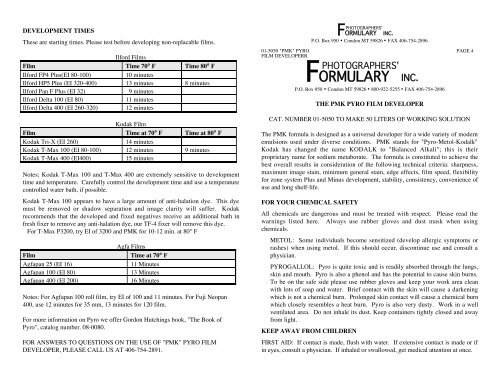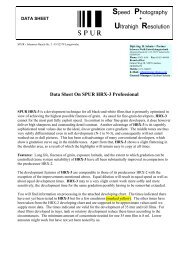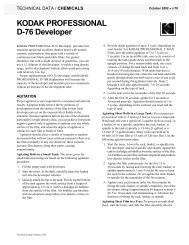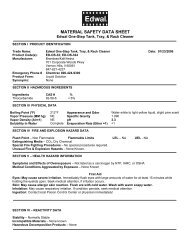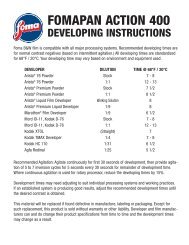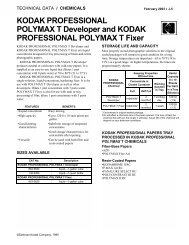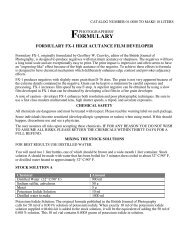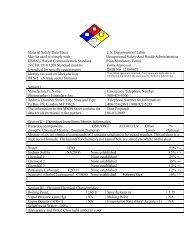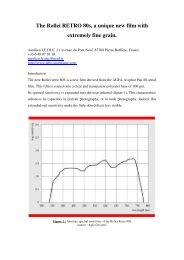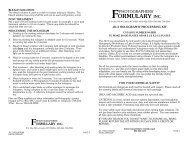Instructions & Technical Data (pdf)
Instructions & Technical Data (pdf)
Instructions & Technical Data (pdf)
You also want an ePaper? Increase the reach of your titles
YUMPU automatically turns print PDFs into web optimized ePapers that Google loves.
DEVELOPMENT TIMES<br />
These are starting times. Please test before developing non-replacable films.<br />
Ilford Films<br />
Film Time 70° F Time 80° F<br />
Ilford FP4 Plus(EI 80-100)<br />
10 minutes<br />
Ilford HP5 Plus (EI 320-400) 13 minutes 8 minutes<br />
Ilford Pan F Plus (EI 32) 9 minutes<br />
Ilford Delta 100 (EI 80)<br />
11 minutes<br />
Ilford Delta 400 (EI 260-320) 12 minutes<br />
Kodak Film<br />
Film Time at 70° F Time at 80° F<br />
Kodak Tri-X (EI 260)<br />
14 minutes<br />
Kodak T-Max 100 (EI 80-100) 12 minutes 9 minutes<br />
Kodak T-Max 400 (EI400)<br />
15 minutes<br />
Notes: Kodak T-Max 100 and T-Max 400 are extremely sensitive to development<br />
time and temperature. Carefully control the development time and use a temperature<br />
controlled water bath, if possible.<br />
Kodak T-Max 100 appears to have a large amount of anti-halation dye. This dye<br />
must be removed or shadow separation and image clarity will suffer. Kodak<br />
recommends that the developed and fixed negatives receive an additional bath in<br />
fresh fixer to remove any anti-halation dye, our TF-4 fixer will remove this dye.<br />
For T-Max P3200, try EI of 3200 and PMK for 10-12 min. at 80° F<br />
Film<br />
Agfapan 25 (EI 16)<br />
Agfapan 100 (EI 80)<br />
Agfapan 400 (EI 200)<br />
Agfa Films<br />
Time at 70° F<br />
11 Minutes<br />
13 Minutes<br />
16 Minutes<br />
Notes: For Agfapan 100 roll film, try EI of 100 and 11 minutes. For Fuji Neopan<br />
400, use 12 minutes for 35 mm, 13 minutes for 120 film.<br />
For more information on Pyro we offer Gordon Hutchings book, "The Book of<br />
Pyro", catalog number. 08-0080.<br />
FOR ANSWERS TO QUESTIONS ON THE USE OF "PMK" PYRO FILM<br />
DEVELOPER, PLEASE CALL US AT 406-754-2891.<br />
01-5050 "PMK" PYRO<br />
FILM DEVELOPERR<br />
PHOTOGRAPHERS'<br />
INC.<br />
FORMULARY<br />
P.O. Box 950 • Condon MT 59826 • FAX 406-754-2896<br />
PHOTOGRAPHERS'<br />
FORMULARY INC.<br />
P.O. Box 950 • Condon MT 59826 • 800-922-5255 • FAX 406-754-2896<br />
THE PMK PYRO FILM DEVELOPER<br />
PAGE 4<br />
CAT. NUMBER 01-5050 TO MAKE 50 LITERS OF WORKING SOLUTION<br />
The PMK formula is designed as a universal developer for a wide variety of modern<br />
emulsions used under diverse conditions. PMK stands for "Pyro-Metol-Kodalk"<br />
Kodak has changed the name KODALK to "Balanced Alkali"; this is their<br />
proprietary name for sodium metaborate. The formula is constituted to achieve the<br />
best overall results in consideration of the following technical criteria: sharpness,<br />
maximum image stain, minimum general stain, edge effects, film speed, flexibility<br />
for zone system Plus and Minus development, stability, consistency, convenience of<br />
use and long shelf-life.<br />
FOR YOUR CHEMICAL SAFETY<br />
All chemicals are dangerous and must be treated with respect. Please read the<br />
warnings listed here. Always use rubber gloves and dust mask when using<br />
chemicals.<br />
METOL: Some individuals become sensitized (develop allergic symptoms or<br />
rashes) when using metol. If this should occur, discontinue use and consult a<br />
physician.<br />
PYROGALLOL: Pyro is quite toxic and is readily absorbed through the lungs,<br />
skin and mouth. Pyro is also a phenol and has the potential to cause skin burns.<br />
To be on the safe side please use rubber gloves and keep your work area clean<br />
with lots of soap and water. Brief contact with the skin will cause a darkening<br />
which is not a chemical burn. Prolonged skin contact will cause a chemical burn<br />
which closely resembles a heat burn. Pyro is also very dusty. Work in a well<br />
ventilated area. Do not inhale its dust. Keep containers tightly closed and away<br />
from light.<br />
KEEP AWAY FROM CHILDREN<br />
FIRST AID: If contact is made, flush with water. If extensive contact is made or if<br />
in eyes, consult a physician. If inhaled or swallowed, get medical attention at once.
IF FOR ANY REASON YOU DO NOT WISH TO ASSUME ALL RISKS IN<br />
USING THESE CHEMICALS, PLEASE RETURN FOR A CREDIT.<br />
Please consult with local sewer and water authorities regarding the proper disposal of<br />
darkroom chemicals in your area.<br />
01-5050 "PMK" PYRO<br />
FILM DEVELOPER<br />
PHOTOGRAPHERS' FORMULARY<br />
800-922-5255 PAGE 1<br />
PMK STOCK SOLUTIONS<br />
A Solution 500 ml B Solution 1000 ml<br />
Distilled Water 75°F 400 ml Distilled Water 75°F 700 ml<br />
Metol 5.0 gr. Sodium Metaborate 300 gr.<br />
Sodium Bisulfite 10.0 gr. Distilled water to Make 1000 ml<br />
Pyrogallol<br />
50.0 gr.<br />
Distilled water to make 500 ml<br />
MIXING THE STOCK SOLUTIONS<br />
STOCK SOLUTION A: Distilled water is recommended, but filtered tap water can<br />
be used. Take a small pinch of sodium bisulfite and add it to the water. Add the<br />
metol to the "A" solution and stir until it is dissolved completely. Add the remaining<br />
sodium bisulfite and stir until dissolved. Add the pyro to the stock solution outside or<br />
under a ventilating hood. Stir until pyro is dissolved completely.<br />
STOCK SOLUTION B: Distilled water is a MUST for solution "B". This solution<br />
is highly concentrated and a considerable quantity of the sodium metaborate may<br />
precipitate if the water is not pure. Dissolve the chemical in distilled water. Any<br />
residual amount of this chemical will dissolve by itself after 24 hours. The small<br />
amount of residual left will not affect the solution activity even if used immediately.<br />
The shelf life of the stock solution is indefinite. Partially filled and stoppered bottles<br />
will last for years. Glass bottles are preferred for the storage of developer solutions,<br />
but plastic is also acceptable.<br />
Clear bottles are fine for PMK if stock solution "A" is kept out of strong light. After<br />
a week or two, the color of stock solution "A" will turn a pale yellow color. This is<br />
the equilibrium point and no further change will occur.<br />
WORKING SOLUTION OF PMK<br />
1 Part A + 2 Parts B + 100 Parts of water<br />
Example: 10ml A + 20 ml B + 1000 ml of water make approximately one liter of<br />
working solution. Measure the quantity of water and add the A and B stock<br />
solutions. It does not matter whether A or B is added first.<br />
Note: When PMK is mixed together, the solution will immediately proceed through<br />
color changes from gray-green to pale amber. This is an important visual check of<br />
solution activity. If there is no color change, something is wrong. Recheck your<br />
stock solution for correct formulation. Use immediately.<br />
CAPACITY OF PMK<br />
PMK is a one-shot developer. Because it is so dilute, a minimum of 300 ml of<br />
developer per 80 square inches of film (one roll of 36 exposure 35 mm film, or four<br />
4 by 5 negatives) must be present in the tank or tray.<br />
01-5050 "PMK" PYRO<br />
FILM DEVELOPER<br />
PHOTOGRAPHERS' FORMULARY<br />
800-922-5255 PAGE 2<br />
Inconsistencies can result by varying the ratio of film to quantity of developer used.<br />
Best results will be obtained by keeping the amount of PMK per roll consistent.<br />
AGITATION PROCEDURE<br />
If using tank developing, rap the tank sharply on a counter 3-5 times immediately<br />
after filling with developer to dislodge any air bubbles. Agitate vigorously with two<br />
complete inversions every 15 seconds. Invert the tank in a different direction each<br />
time, and then leave idle until until next next cycle.<br />
If using trays use a tray one size larger than the film. Begin agitation immediately<br />
and vigorously. The film should make a “clack” sound against the tray. Some<br />
developer should spill into the sink. Wear gloves. Tip trays once or twice every 15<br />
seconds. Tip from each of the sides in rotation for successive cycles. Allow the tray<br />
to sit idle between each cycle.<br />
FILM DEVELOPMENT TEMPERATURE<br />
The conventional temperature for film development is 68°F (20° C) or 70°F. During<br />
the summer month in many parts of the country, cold tap water is often much<br />
warmer than 70°F. To bring this temperature down with ice cubes is inconvenient, to<br />
say the least. For PMK each degree of increased developer temperature, decrease the<br />
development time by 4%. Do not hesitate to use the higher temperatures. With<br />
appropriate reduction in development time, no loss of quality in the negative will<br />
result.<br />
STOP AND FIXING BATHS<br />
A plain water stop bath is excellent for all normal films and developers. Use a large volume of<br />
water and agitate roll and sheet film continuously. Use of an acid stop bath will strip the pyro<br />
stain.<br />
We recommend using our TF-4 non-acidic fixer (cat. no. 03-0141), since fixers with hardening<br />
agent will decrease the image stain, therefore, the use of non-hardening fixers is necessary. Do<br />
not use TF-4 with an acid stop bath. Do not exceed manufacturer's recommended fixing time.
PYRO AFTER BATH<br />
Place all negatives direct from fixer, into the used developer for two minutes. Agitate every<br />
30 seconds. The alkali after bath induces the formation of stain in the developed negative. An<br />
alternative alkaline after bath can be used if desired. The use of 5 grams of sodium metaborate<br />
per liter of water is the alternative.<br />
FINAL WASH<br />
Wash film in running water for 20-30 minutes. Wash all films for at least 20 minutes.<br />
The image stain intensifies during the wash cycle.<br />
01-5050 "PMK" PYRO<br />
FILM DEVELOPER<br />
PHOTOGRAPHERS' FORMULARY<br />
800-922-5255 PAGE 3


